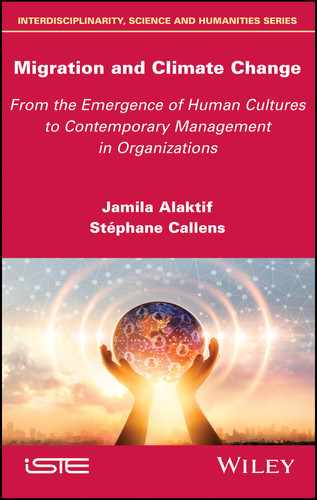This book aims to provide a better understanding of how human cultures interact with climate change over an extended period of time. It is an analysis of the past and present, ranging from the first human migration to contemporary organizational management using an approach developed by Michel Foucault, defined as: the research, the practice, the experience, by which the subject operates on themselves the transformations necessary in order to have access to the truth. This book consists of two parts. The first part focuses on climate change and the substantial effects it had on the first human cultures. The second part explores the role of organizations and the development of new frameworks for action in more recent times of anthropogenic climate change.
Table of Contents
- Cover
- Introduction
- I.1. Human diversity and climate
- I.2. Effects of climate change on cultural and spiritual transformations
- I.3. Cultural and spiritual transformations: a methodology from Michel Foucault’s work
- I.4. The major role of intermediary structures: organizations in large-scale climate changes
- I.5. Overview of the book
- PART 1: The First Cultures in a Context of High Climate Instability
- 1 Migration and Creativity: What Roles do They Play During Climate Change?
- 1.1. A necessary evil
- 1.2. Cultures and climatic gradient
- 1.3. The conquest of ubiquity
- 1.4. Migration: capacity or necessity?
- 1.5. The oboes of the Swabian Jura
- 1.6. Discussion
- 2 Living with the Extreme
- 2.1. The example of super-flooding
- 2.2. In search of a new interpretative framework
- 2.3. Extreme measurements
- 2.4. The first GLOF cultures
- 2.5. The first cultural groups of anatomically modern humans and climate change
- 2.6. The problem of Apollo’s birth
- 2.7. The constitution of dragons, gods and humans in the myths of the flooding of hydraulic civilizations
- 2.8. Discussion
- 3 The Great Historical Transitions of Climate Cultures
- 3.1. Historical human cultures, between fiction and knowledge of natural risks
- 3.2. Water, a historical problem, from Mesoamerica to Africa
- 3.3. Human diversity and taiga shamanism
- 3.4. Spiritual corporalities of body paintings
- 3.5. Myths linked to the problem of water: first texts and first empires
- 3.6. Discussion: the politicization of corporalities
- PART 2: Contemporary Cultures and Climate Change
- 4 Norms and Diversity in Climate Change
- 4.1. Climate change and normativity
- 4.2. Normativity and diversity
- 4.3. The hard and soft law discussion
- 4.4. Normativity and climate migration
- 5 Organization, Climate and Sustainable Development
- 5.1. Organizations and time horizons: Beck’s theory
- 5.2. Corporate social responsibility (CSR)
- 5.3. Organization and decentralization in the energy transition: the example of Senegal
- 6 Climate and Religion in Protectionism
- 6.1. Climate change and protectionism
- 6.2. Mercantilism and religion
- 6.3. Parliamentary protectionism and religion: a comparison of France and the United States
- 6.4. Interfaith dialogue and fundamentalism
- Conclusion
- Glossary
- References
- Index
- End User License Agreement
